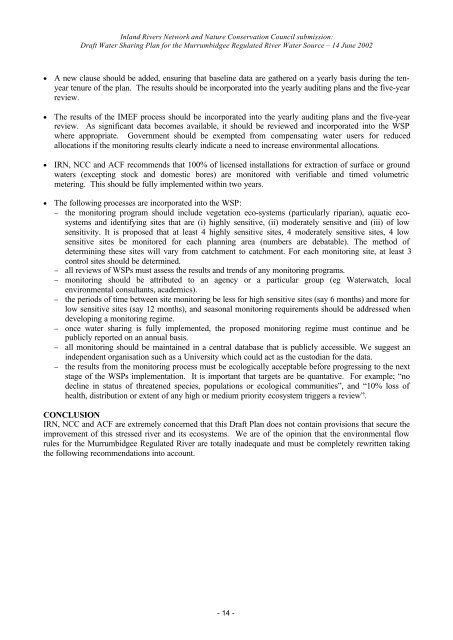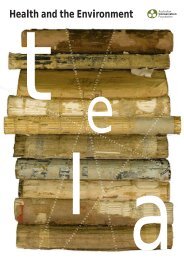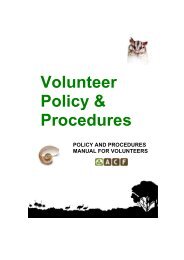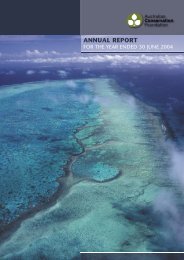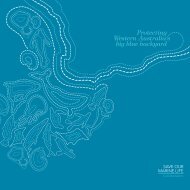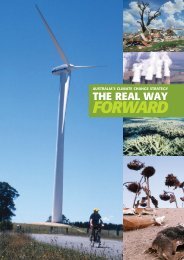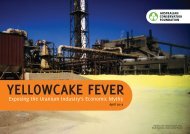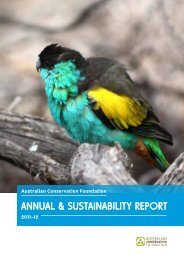Submission on Draft Water Sharing Plan for the Murrumbidgee River
Submission on Draft Water Sharing Plan for the Murrumbidgee River
Submission on Draft Water Sharing Plan for the Murrumbidgee River
You also want an ePaper? Increase the reach of your titles
YUMPU automatically turns print PDFs into web optimized ePapers that Google loves.
Inland <strong>River</strong>s Network and Nature C<strong>on</strong>servati<strong>on</strong> Council submissi<strong>on</strong>:<br />
<strong>Draft</strong> <strong>Water</strong> <strong>Sharing</strong> <strong>Plan</strong> <strong>for</strong> <strong>the</strong> <strong>Murrumbidgee</strong> Regulated <strong>River</strong> <strong>Water</strong> Source – 14 June 2002<br />
• A new clause should be added, ensuring that baseline data are ga<strong>the</strong>red <strong>on</strong> a yearly basis during <strong>the</strong> tenyear<br />
tenure of <strong>the</strong> plan. The results should be incorporated into <strong>the</strong> yearly auditing plans and <strong>the</strong> five-year<br />
review.<br />
• The results of <strong>the</strong> IMEF process should be incorporated into <strong>the</strong> yearly auditing plans and <strong>the</strong> five-year<br />
review. As significant data becomes available, it should be reviewed and incorporated into <strong>the</strong> WSP<br />
where appropriate. Government should be exempted from compensating water users <strong>for</strong> reduced<br />
allocati<strong>on</strong>s if <strong>the</strong> m<strong>on</strong>itoring results clearly indicate a need to increase envir<strong>on</strong>mental allocati<strong>on</strong>s.<br />
• IRN, NCC and ACF recommends that 100% of licensed installati<strong>on</strong>s <strong>for</strong> extracti<strong>on</strong> of surface or ground<br />
waters (excepting stock and domestic bores) are m<strong>on</strong>itored with verifiable and timed volumetric<br />
metering. This should be fully implemented within two years.<br />
• The following processes are incorporated into <strong>the</strong> WSP:<br />
− <strong>the</strong> m<strong>on</strong>itoring program should include vegetati<strong>on</strong> eco-systems (particularly riparian), aquatic ecosystems<br />
and identifying sites that are (i) highly sensitive, (ii) moderately sensitive and (iii) of low<br />
sensitivity. It is proposed that at least 4 highly sensitive sites, 4 moderately sensitive sites, 4 low<br />
sensitive sites be m<strong>on</strong>itored <strong>for</strong> each planning area (numbers are debatable). The method of<br />
determining <strong>the</strong>se sites will vary from catchment to catchment. For each m<strong>on</strong>itoring site, at least 3<br />
c<strong>on</strong>trol sites should be determined.<br />
− all reviews of WSPs must assess <strong>the</strong> results and trends of any m<strong>on</strong>itoring programs.<br />
− m<strong>on</strong>itoring should be attributed to an agency or a particular group (eg <strong>Water</strong>watch, local<br />
envir<strong>on</strong>mental c<strong>on</strong>sultants, academics).<br />
− <strong>the</strong> periods of time between site m<strong>on</strong>itoring be less <strong>for</strong> high sensitive sites (say 6 m<strong>on</strong>ths) and more <strong>for</strong><br />
low sensitive sites (say 12 m<strong>on</strong>ths), and seas<strong>on</strong>al m<strong>on</strong>itoring requirements should be addressed when<br />
developing a m<strong>on</strong>itoring regime.<br />
− <strong>on</strong>ce water sharing is fully implemented, <strong>the</strong> proposed m<strong>on</strong>itoring regime must c<strong>on</strong>tinue and be<br />
publicly reported <strong>on</strong> an annual basis.<br />
− all m<strong>on</strong>itoring should be maintained in a central database that is publicly accessible. We suggest an<br />
independent organisati<strong>on</strong> such as a University which could act as <strong>the</strong> custodian <strong>for</strong> <strong>the</strong> data.<br />
− <strong>the</strong> results from <strong>the</strong> m<strong>on</strong>itoring process must be ecologically acceptable be<strong>for</strong>e progressing to <strong>the</strong> next<br />
stage of <strong>the</strong> WSPs implementati<strong>on</strong>. It is important that targets are be quantative. For example; “no<br />
decline in status of threatened species, populati<strong>on</strong>s or ecological communities”, and “10% loss of<br />
health, distributi<strong>on</strong> or extent of any high or medium priority ecosystem triggers a review”.<br />
CONCLUSION<br />
IRN, NCC and ACF are extremely c<strong>on</strong>cerned that this <strong>Draft</strong> <strong>Plan</strong> does not c<strong>on</strong>tain provisi<strong>on</strong>s that secure <strong>the</strong><br />
improvement of this stressed river and its ecosystems. We are of <strong>the</strong> opini<strong>on</strong> that <strong>the</strong> envir<strong>on</strong>mental flow<br />
rules <strong>for</strong> <strong>the</strong> <strong>Murrumbidgee</strong> Regulated <strong>River</strong> are totally inadequate and must be completely rewritten taking<br />
<strong>the</strong> following recommendati<strong>on</strong>s into account.<br />
- 14 -


